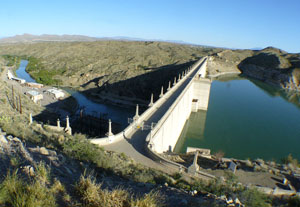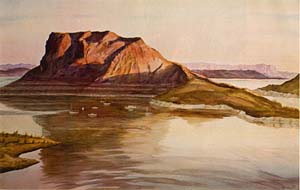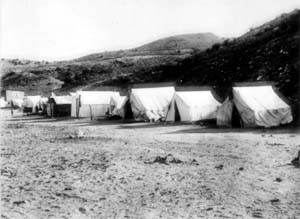
In Spanish, the word Rio means river, and the Rio Grande, of course, is the magnificent river that forms the southern border of Texas. From its headwaters in the San Juan Mountains of southern Colorado, the Rio Grande flows 1,865 miles south on its way to the Gulf of Mexico. All but 600 of those miles form the U.S. border with Mexico. In an arid countryside of sagebrush, mesquite, and rattlesnakes, the Rio Grande has been the source of life for centuries of human occupation.
The lower river’s modern era began in 1916 when the U.S. Reclamation Service (today’s Bureau of Reclamation) completed Elephant Butte Dam on the Rio Grande, 125 miles north of El Paso. Elephant Butte Dam, named for a distinctive rock formation that now juts from the reservoir, not only makes a dependable water supply possible, but Elephant Butte Lake has a storage capacity of more than 2.2 million acre feet, making it the largest irrigation reservoir in the world at the time of construction. In addition, Elephant Butte Dam and its irrigation system were the first to touch off an international debate about the allocation of water between Mexico and the United States.
When Spanish conquistadors first made their way up the Rio Grande in the 1530s, they found Pueblo people irrigating and cultivating almost 30,000 acres of maize, beans, and squash near present day Juarez, Mexico. When Spanish priests established missions, they, too, irrigated the land until the 1680 Pueblo Revolt forced the Spanish out of present-day New Mexico. Spain soon re-conquered the region, however, and over the next century tilled as much as 40,000 acres along the Rio Grande. Following Mexican independence in 1821, settlers at Juarez dug modest canals and built a loose boulder dam, which diverted the Rio Grande to the town of El Paso, founded in 1827. Eager to settle their country’s northern frontier, the Mexican government, as had the Spanish, issued land grants to communities and individuals. It was on a former land grant, once owned by Don Juan Garcia, that the Bureau of Reclamation built Elephant Butte Dam and other units of the Rio Grande Project.
The Mexican War ended in 1848, but disputes over rights to the Rio Grande continued. In 1897, the private Rio Grande Dam & Irrigation Company proposed to build a low dam at Elephant Butte to serve a few landowners. When the company made no plans to divert surplus water south of the border, Mexico objected. The case went to court, and the irrigation company’s project never materialized because the United States sided with its neighbor, ruling that the project violated Mexico’s water rights by restricting the southward flow of the Rio Grande. Not only did Texas, New Mexico, and southern Colorado’s San Luis Valley depend on the Rio Grande, but also the Mexican border states of Chihuahua, Coahuila, Nuevo León and Tamaulipas.
The Rio Grande Dam & Irrigation Company was not the only entity to envision damming the Rio Grande. In March 1903, the brand new U.S. Reclamation Service conducted surveys of the bedrock in south-central New Mexico and a year later settled on a site to build a dam near the town of Engle, which, at the time, was a thriving station on the Atchison, Topeka and Santa Fe Railway. A dozen miles to the west, the eroded cone of an ancient volcano reminded some of the head of an elephant. Here, Reclamation would build the 301-foot-high, concrete gravity Elephant Butte Dam, but only after the United States promised on May 21, 1906 (by way of a treaty with Mexico) to allow Mexico to receive 60,000 acre feet of water a year from the Rio Grande. In return, Robert Autobee writes, Mexico waived all claims to the river above the town of Fort Quitman, Texas, and all demands for past damages from water shortages. Water shortages, caused by extensive irrigation on northern stretches of the river in Colorado’s San Luis Valley, were apparent as early as the 1890s. One report stated that an estimated 925 ditches were drawing water out of the Rio Grande before the river left Colorado.

Reclamation favored a dam at New Mexico’s Elephant Butte, where Rio Grande water could be stored for use in the region’s Rincon, Mesilla, and El Paso valleys. However, the International Dam Commission, an assembly of Mexican and American engineers, wanted the dam to straddle the U.S.-Mexican border and for Mexico to own half of the dam, reservoir, and water supply. The commission lost the location battle, and Reclamation’s Rio Grande Project went forward even before the 1906 treaty was signed.
On February 25, 1905, Congress authorized construction of what originally was called Engle Dam, and area settlers, eager for Federal help in irrigating their lands, organized water users associations. That December, Secretary of the Interior Ethan A. Hitchcock approved the Rio Grande Project, which was among the earliest undertaken by the Reclamation Service, created to administer the Reclamation Act of 1902. The act committed the Federal Government to build irrigation works--dams, reservoirs, and canals--in 16 arid and semi-arid Western states and territories, including New Mexico, which did not attain statehood until 1912. Texas was not included as an original Reclamation state but was added in 1906 because it also stood to benefit from the Rio Grande Project.
The project kicked off with the building of a work camp and a 12.8-mile rail line to connect with the Santa Fe at Engle. With the final spike driven early in 1911, the train not only carried supplies to the camp, but also two sightseeing cars for the curious. Elephant Butte Dam has a smooth, concrete face, though construction of the dam involved the cyclopean technique, whereby large rocks known as plumstones were embedded in the masonry. The concrete pour, which began on June 3, 1913, was carried to the dam over a cable system powered by a 300-horsepower electric motor. By the summer of 1914, blocks of masonry about 100 feet long and of different heights rose from the bed of the Rio Grande. While the concrete was wet but of sufficient thickness, teams of men, with the help of a derrick, placed the plumstones. These plumstones account for 15 percent of the dam’s volume.
Work went on day and night (except for a day of rest on Sundays). When Union leaders complained that contractors were taking jobs from Americans by bringing in less-expensive workers from Mexico, Reclamation Director Frederick H. Newell wrote to Texas Senator Morris Sheppard, urging that jobs be limited to American citizens. In the work camp, a Mexican family ran a boarding house, serving meals said to be more savory and less costly than the kitchen run by the Reclamation Service. Although the outbreak of the Mexican Revolution did not stall work at Elephant Butte, a stir ran through camp in March 1916 with news that a band led by Pancho Villa had crossed the border and killed 16 Americans at Columbus, New Mexico.

Elephant Butte Dam was completed in 1916, with a series of concrete lampposts standing watch over its downstream side, its crest extending 1,674 feet with a road running across the top. Elephant Butte’s ogee weir spillway also was finished in 1916, but a channel and downstream concrete-lined chute took another six years to complete, in part because engineers rerouted the chute when they discovered better foundation rock. Additional spillway capacity comes from four large wells controlled by steel gates. During construction of Elephant Butte Dam, gates and six penstock openings were built into the dam, but demand for electricity in the rural area was so low that hydroelectric generation was shelved until 1940, when a powerplant was placed in operation after the completion of the downstream Caballo Dam.
Today, 28 varieties of crops, with pecans and cotton as king, are grown on Reclamation’s Rio Grande Project. Green onions, peppers, and alfalfa also figure prominently on the Rio Grande Project, which supplies irrigation water for about 178,000 acres in south-central New Mexico and west Texas.
In 1997, the Elephant Butte Irrigation District, which includes 217 contributing features, including Leasburg and Percha diversion dams, was listed on the National Register. Also on the National Register is the Elephant Butte Historic District, which incorporates the individually listed Elephant Butte Dam, as well as an array of surrounding buildings, structures, and archeological sites that directly relate to the construction and subsequent operation of the dam and reservoir. Features include the original Reclamation Service office building for the project and camps established by construction workers. Many surviving buildings and structures date to the New Deal-era, when young men with the Civilian Conservation Corps built a boat house, still-in-use fish hatchery, and lakeside tourist cabins in the Pueblo Revival style. Landscaping, roads, and a campground still bear the mark of the CCC at Elephant Butte State Park. Elephant Butte Dam and its reservoir are also designated as a National Historic Civil Engineering Landmark.
Visit the National Park Service Travel Bureau of Reclamation's Historic Water Projects to learn more about dams and powerplants.
Last updated: January 13, 2017
